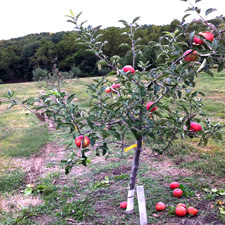7 days past the Spring Equinox of 12:37pm ET March 20, 2017 when the sun crosses the celestial equator to enter the sky’s northern hemisphere. Usually this signals the warming trend of a changing season headed our way. However……. Snow depth in my backyard: 8” to 24” depending where you stand. Snow depth in my apple orchard: 2/3 the height of the trees. {In other words,
almost covered}. Winter continues to press on. Sleet bounces off my living room window as I write this installment. The heat from my fireplace warms both me and Bailey, my 5 year old Australian Shepherd rescue buddy from Louisiana. We are hunkering down today in search of a warm topic for discussion. With an apple pie simmering in my oven, and a view of my young apple orchard being pelted by sleet out my window, what better subject to talk about today than apples!
I planted my 6 apple trees in an unused section of my side yard in May of 2016 and followed all the instructions that I offer to you today.
 
Location: Choose a spot with full to nearly full sun all day. My trees are young and still growing and they are in a partial to full sun area. After 2 years in the ground, I expect apples this year but probably not much of a yield for both of those reason. Hills and sloping areas are acceptable planting areas, just be sure not to plant where there is a chance of standing or pooling water in the spring.
Air Circulation: Avoid windy locations, but allow for good air circulation. This helps keep the bugs down and aids with cross pollination.
Drainage / Soil: Fertile, well drained and slightly acidic soil is best. Again, never plant where standing water might occur. If your soil is sandy or clay, enhance the soil before planting with an organic mixture like composted cow manure.
How to plant the trees: Plant in the spring after fear of frost is gone. Begin by digging a hole 2 feet deep and double the diameter of the root ball. If your soil is poor, make a larger hole to allow for adding the enhancements, and back fill. Do not back fill your tree above the level of the soil that was in the planting pot. Tamp the soil but do not compact it too firmly. It is a good idea to stake young trees for several years to keep them growing straight and tall. I wrap the tree trunks with a flexible plastic protector in the fall and winter to prevent little voles or moles from chomping on the tree bark. Take it off in spring and summer. Cover the planting area with any type of mulch your prefer to help keep the moisture in the ground and keep the weeds down.
Water: Water new trees heavily and regularly the first year and do so right up to early fall.
Fertilizer: Some growers do not bother to fertilize, but I did. In spring and early fall fertilize until trees are well established, and try a slow release fertilizer like “Plant Tone” for uniform growth above and below ground.
Type of tree: Choose an apple variety that you like and there are many, but here I mean to suggest size of tree:
Standard growth tree: will grow 25’ tall and wide.
Semi-dwarf growth tree will grow 15’ tall and wide.
Dwarf growth tree will grow under 10’ tall and wide.
The tree size that you choose will depend on a lot of things, such as space available, how much time you want to spend maintaining it, type of apple you want, how much equipment you will need to prune, spray, climb to harvest etc. For myself, as a small (short) farmer, the semi-dwarf size apple tree suited me best.
Spraying: With new young trees, start with an application of Hi-yield Lime Sulfur to kill off disease spores that overwintered on the tree. After that, apply Bonide All-Season Oil to kill insect eggs that overwintered. With blossoms on the tree, but before the blossoms open, apply weekly any general fruit tree spray for insect control. Once the blossoms open, you can stop the weekly spraying and let the worker bees start pollinating. Strongly suggest using an organic insect spray to protect the humble bumble bees. Maybe an even better way to protect our precious bees, Paul Parent suggests a new insect repellent for fruit trees called Bayer Advanced, Fruit, citrus & Vegetable Insect Control. It gives all season long protection w/o spraying. Kills insects and prevents infestations, rain proof, just mix and pour on the ground, stays only in the foliage and will not enter the fruit. It is a new systemic foliage insect control. Might be worth a try once you can find your trees under the snow.
Now, about that apple pie……
Cheers,
Deb (April 2017 Horticultural Newsletter)
Ref: Paul Parent Newsletter - March 3, 2011
|